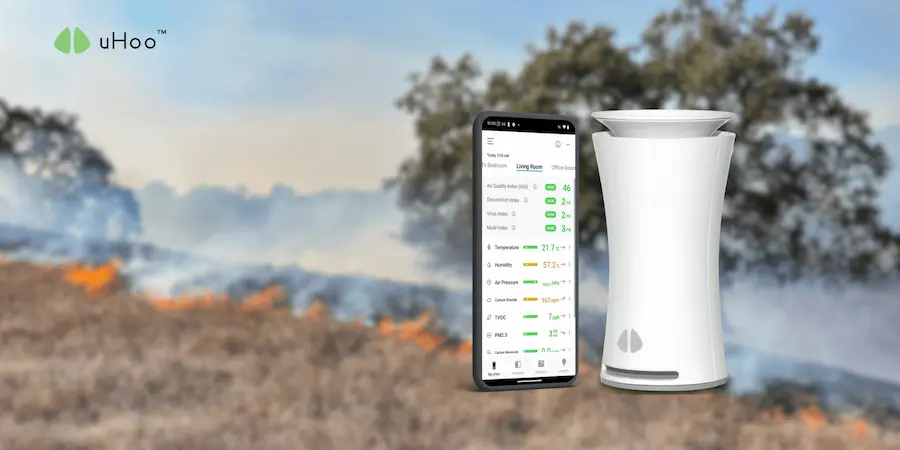Wildfire air pollution can be concerning. The tiny, harmful particles in smoke (PM2.5) can pose serious health risks, even when originating from distant blazes. The key is to take swift, actionable steps to protect yourself and your family. Knowing how to manage wildfire air pollution proactively is essential for maintaining a healthy indoor environment.
Here’s actionable advice on how to manage wildfire air pollution:
- Stay Informed with Real-Time Air Quality Data: When learning how to manage wildfire pollution, don’t rely solely on visual cues or smell. Your first step should always be to check the Air Quality Index (AQI) for your area. Many local environmental agencies provide this data. Your uHoo app can often integrate with this external data, giving you a quick overview of outdoor air quality. This information is critical for deciding when to implement indoor protective measures.
- Create a Sealed Indoor Environment: Your home is your best defense. As soon as outdoor air quality is impacted by smoke, close all windows and doors. Check for and seal any obvious gaps around frames, vents, and pet doors using weatherstripping, towels, or even duct tape for temporary measures. The goal when learning how to manage wildfire pollution is to minimize smoke infiltration.
- Optimize Your Air Conditioning (AC) System: Your AC can either contribute to the problem or be part of the solution. Set your central AC to “recirculate” mode to prevent drawing in outdoor air. Ensure that any “fresh air intake” vents on your system are closed. Regularly clean or replace your AC filters; consider upgrading to a MERV 13 or higher filter if your system is compatible, as these are more effective at trapping fine particles.
- Deploy High-Efficiency Air Purifiers: Portable air purifiers with true HEPA filters are highly effective at removing the fine particulate matter from wildfire smoke. Place them in the rooms where you spend the most time, such as bedrooms and living areas. Ensure the purifier’s Clean Air Delivery Rate (CADR) is appropriate for your room size.
- Avoid Indoor Activities That Generate Pollutants: When smoke is present outdoors, avoid adding to indoor pollution. Refrain from burning candles, incense, or using fireplaces. Limit frying or grilling indoors, as cooking smoke can significantly increase indoor particulate levels. If you must vacuum, use a vacuum with a HEPA filter to avoid stirring up settled smoke particles.
- Limit Outdoor Exposure and Adjust Activity Levels: While learning how to manage wildfire pollution, reduce time spent outdoors, especially for children, the elderly, and those with respiratory or cardiovascular conditions. Avoid strenuous outdoor exercise. If you must go outside, consider wearing a well-fitting N95 or KN95 mask to filter out particles.
- Monitor Indoor Air Quality Continuously with uHoo: Even with precautions, smoke can still find its way indoors. Your uHoo air quality monitor provides real-time data on indoor PM2.5 levels. By continuously monitoring, you can see if your efforts are effective. If indoor PM2.5 levels remain high or rise, it indicates that smoke is infiltrating, allowing you to adjust your strategies and truly understand how to manage wildfire air pollution in your home.
By proactively implementing these actionable tips on how to manage wildfire pollution, you can significantly reduce your exposure to wildfire smoke and maintain healthier air inside your home during these challenging events.

